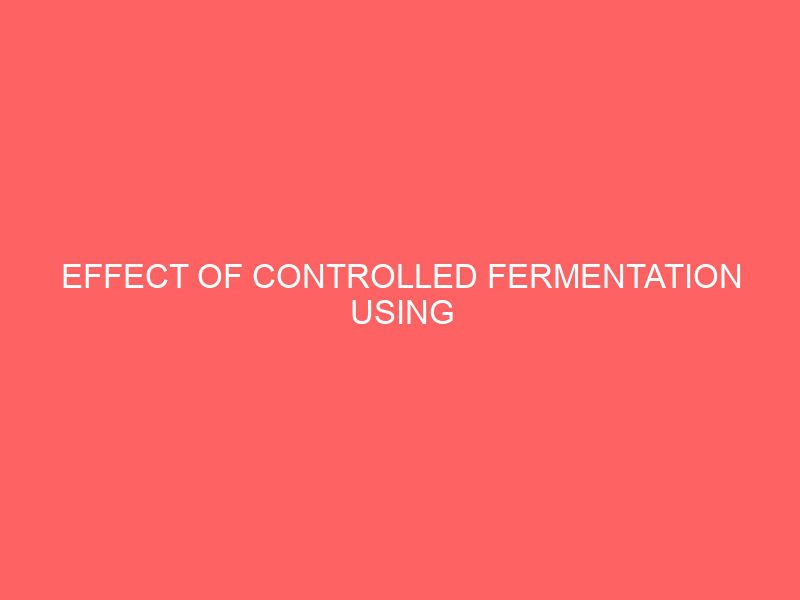Description
CHAPTER 1
INTRODUCTION
This research is on Effect of controlled fermentation using aspergillus niger and trichoderma harzanium on nutrient composition of pre-treated bengal indigo (indigofera arrecta) seeds.
The genus Indigofera Linn. is a large genus of about 700 species of flowering plants belonging to the sub-family Papilionoideae in the family Fabaceae / Leguminosae. They occur throughout the tropical and subtropical regions of the world. Burkill (1995) recognized 60 species while Soladoye and Lewis (2003) recorded 60 species in Nigeria with over 60% abundance in the Northern region of the country with 27 species distributed across the South Western area of the country. Indigofera in Greek means indigo dye which is famous for the natural blue colors obtained from the leaflets and branches of this herb. The most important of the species are Indigofera arrecta and Indigofera tinctoria.
Indigofera spp. display excellent adaptation to a range of environments, and possess diverse morphological and agronomic attributes, significant to their use as forage and cover crops (Hassen et al., 2006). Some of these species, Indigofera tinctoria and Indigofera suffruticosa are used to produced indigo dyes while some have medicinal values such as Indigofera articulate used for the treatment of toothache,
Indigofera oblongifolia, Indigofera suffruticosa and Indigofera aspalthoides are used as anti–inflammatories for treatment of insect stings, snake bites and swellings (Shahjahan et al., 2005); and Indigofera arrecta extract is used to relieve ulcer pain.
The stem of Indigofera tinctoria is chewed to cure cough and decoction of leaves is used to cure chest pains, epilepsy, nervous disorders, asthma, bronchitis, fever and complaints of stomach, liver, kidney and spleen- especially in Cameroon (Takawira-Nyenya and Cardon, 2005). The twine paste cures dislocation. Also the warm leaves dismiss bruises (Ibe and Nwufo, 2005). Phytochemical investigation of Indigofera species shows that they are rich in organic and fatty acids, flavonoids such as carotenoids and coumarins (Yinusa et al., 2007).
Indigofera arrecta is readily found in abundance in the locality of Samaru- Zaria, Kaduna State and the young leaves are eaten as vegetable. In the northern part of the country among the Hausa, it is called ―Ba-ba‖, in the south-west among the Yoruba, it is known as ―Elu-aja‖ and in eastern part of the country among the Igbos, it is known as ―Uri‖. Indigofera arrecta seeds contain several anti-nutritional factors which limit their consumption and affect the digestibility and bioavailability of nutrients. Seeds are well known rich sources of minerals but the bioavailability of these minerals is usually low due to the presence of antinutrients and enzyme inhibitors (Valencia et al., 1999). These antinutrients and enzyme inhibitors interfere with absorption of nutrients from foodstuff thus affecting their metabolism. The seed of Indigofera arrecta is known for its hardness which is due to the presence of a hard seed coat which is the seed‘s primary defense against adverse environmental conditions. Seed hardness is the effect of two components: hardness of the seed coat and hardness of the seed interior. Hardness is related to seed coat (testa) impermeability and also to cotyledon impermeability. In the testa it may involve lignins as well as tannins, whereas in cotyledons it may be primarily lignification as cotyledons have low concentrations of phenolic compounds. Some anti-nutritional factors such as trypsin and cysteine inhibitors and lectins are heat-labile compounds and their negative effects are, therefore, markedly reduced by cooking (Boufassa,et al., 1986; Akinyele, 1989), while tannins and phytic acid are heat-stable compounds that retain negative effects on mineral and protein bioavailability after cooking (Ogun et al., 1989).
All necessary experimental steps employed in producing fermentable substrates are referred to in a single term as pretreatment. Pretreatment strategies have generally been categorized into biological, physical and chemical processes, or a combination of these approaches.Pretreatments change the structure of cell walls and polymers by disrupting intermolecular forces holding them together, allowing greater access by enzymes and water. Phenolic compounds in the seed coat contribute to seed hardness and inhibition of microorganism growth hence the need for pretreatment in order to increase the accessibility to enzyme hydrolysis or fermentation.
The presence of lignin also impedes enzymatic hydrolysis, as enzymes bind onto the surface of lignin and hence do not act on the cellulose chains (Palonen et al., 2004). Biodegradability can be enhanced by pretreatment of lignocellulolytic materials, including acid or alkali treatment, ammoniaand urea, physical grinding and milling, fungal degradation and steam explosion, and combined alkali and heat treatment (Galbe and Zacchi, 2007). Gharpuray et al.(1983) examined several of these pretreatment options individually and in combination, and found that those treatments which enhanced specific surface area were most effective at increasing enzymatic hydrolysis.
Fermentation has always been an important part of human lives with exclusive benefits as food. It can produce vital nutrients or eliminate antinutrients. Several experiments have demonstrated that fermentation of legumes enhances their nutritive value (Zamora et al., 1979; Akpapunam and Achinwehu, 1985), reduces some anti-nutritional endogenous compounds such as phytic acid (Kozlowska et al., 1996), and exerts beneficial effects on protein digestibility and biological value of legumes.
Trichoderma spp. and Aspergillus spp. are good secretors of lignocellulolytic enzymes(Archer and Peberdy, 1997). They are producers of tannase (Dapiya et al., 2010) and phytase (Aseri et al., 2009, Newkirk et al., 2001) which are two enzymes capable of degrading tannin and phytic acid respectively. The incubation of substrate with Trichoderma harzanium and Aspergillus nigermarkedly reduce the phytate and tannin in Jatropha curcas seeds(Balewuet al.,2011). Efforts have been focused on how to combine pretreatment and solid state fermentation to maximize productivity and to make the overall process economically efficient.
This study is aimed at evaluating the effect of pretreatment on nutrient composition of Indigofera arrecta seeds using controlled fermentation by Aspergillus niger and Trichoderma harzanium in mono and co-culture.
- Statement of Research Problem
As the world population continues to increase, food security on a global scale must become an even greater priority. Along with population growth, economic growth and the rise of the middle class in developing countries are expected to further increase demand for meat, milk, and eggs (FAO, 2009).The consumption of conventional feedstuffs like soybean, maize and sorghum by human being is undermining their availability to animals.The price of the conventional source of protein in livestock ration has risen due to competition between man and livestock thus, there is a big challenge of matching available feedstuff supplies with animal needs.Hence, the world is becoming increasingly aware of the looming food insecurity, the possibility of raising animal on unconventional but easily sourced and available feedstuffs in the tropics and subtropics deserves more attention (Belewu et al., 2009).
The primary constraint to livestock production in developing countries is the scarcity and fluctuating quantity and quality of the feed supply.The seed of Indigofera arrecta is an underutilized resource that has received little attention. The plant is readily and abundantly found in farms and wasteland among grasses and is destroyed alongside with grasses during the clearing of the farm. Its usage has been limited probably due to the hardness of the seed and antinutritional content. Hence the need for suitable pretreatment and treatment conditions to enhance its nutritive value. The growth of fungi in natural substrates is usually slow and this limitation must be overcomed by suitable mechanical and chemical pretreatment of the raw substrate (Cen and Xia, 1999). The solid state fermentation of Indigofera arrecta with Trichoderma harzanium and Aspergillus nigermay be a promising method of enhancing the usage of Indigofera arrecta thereby making available renewable feedstuff.
- Justification
In Nigeria, the unbearable scarcity of animal feed motivated nutritionists to look for alternative sources of protein for livestock animals from lesser known seeds like Indigofera arrecta.
The calcium concentration of Indigofera species is relatively high ranging from 0.5 to 2.0%, where normal ranges of 0.20 to over 0.30% would satisfy animal requirement. Crude protein content of Indigofera spp is sufficiently high for consideration of these species as potential protein supplements in low protein quality diets. The amount of the nutritionally essential amino acids present in defatted seed meals of Indigofera species is comparable to that present in legumes (Van Etten et al., 1967). The quantity of non-essential amino acids, glycine, aspartic acid, and serine in these Indigofera species is more compared to the amount found in legumes (Roger et al., 1973). However, they contain several anti-nutritional factors which limit their consumption and affect the digestibility and bioavailability of its nutrients (Bressani, 1993). Antinutritional and toxic factors are considered to defend seeds against environmental vagaries and thus help to protect them. These factors though good for the plant, cause deleterious effect or are even toxic to animals and man. Therefore, fermentation being one of the oldest and most economical method of food production and preservation can be used in an attempt to reduce or eliminate those anti-nutritional factors and hence render the wild Indigofera arrectaseed useful.
The main aim of pretreatment is to increase surface area, to decrystallize cellulose, and to remove hemicellulose and lignin. Pretreatment has to overcome the resistance of the plant cell walls to deconstruction in order to separate the cellulose from lignin and hemicelluloses to make it more accessible to microbes or enzyme hydrolysis (Brodeur et al., 2011). Therefore, choosing the appropriate pretreatment for Indigofera arrecta seeds is a compromise between minimizing the degradation of the hemicellulose and cellulose components while maximizing the ease of fermentation of the substrate using mono and co-culture of Trichoderma harzanium and Aspergillus niger.








Shona –
I appreciate the reviews I am seeing for this material EFFECT OF CONTROLLED FERMENTATION USING ASPERGILLUS NIGER AND TRICHODERMA HARZANIUM ON NUTRIENT COMPOSITION OF PRE-TREATED BENGAL INDIGO (INDIGOFERA ARRECTA) SEEDS, I was pleased to get mine too
Mariah –
Thanks for giving me good insights about my research topic from the material I bought. I appreciate.
Fannie –
I a grateful for this writing it was very helpful
Claribel –
Top notch writing, patronize this guys they are really trying
Etsuko –
I am glad i saw your website, your material is of good quality
gawab –
Gawab here from Ghana, thanks for being honest in sending me this material
Doris –
Hi to you, thanks for this resarch material
Kristen –
I have to thank you for the efforts you’ve put in penning this website.
I am hoping to view the same high-grade content
from you in the future as well. In truth, your creative writing abilities has motivated
me to get into writing
Savannah –
I couldn’t refrain from commenting. Very well written!
Emmanuella –
Thank you for sending me the research material EFFECT OF CONTROLLED FERMENTATION USING ASPERGILLUS NIGER AND TRICHODERMA HARZANIUM ON NUTRIENT COMPOSITION OF PRE-TREATED BENGAL INDIGO (INDIGOFERA ARRECTA) SEEDS I paid for it was top notch. Best wishes
Flor –
I was told to checkout your website and I am pleased i did so
Stevie –
Thanks for a project material EFFECT OF CONTROLLED FERMENTATION USING ASPERGILLUS NIGER AND TRICHODERMA HARZANIUM ON NUTRIENT COMPOSITION OF PRE-TREATED BENGAL INDIGO (INDIGOFERA ARRECTA) SEEDSwell delivered, I need students to believe that you guys are trying
Dorris –
Nice research writing, we are pleased
Ernesto –
Didnt know Nigeria can have good writers like this. Weldone
Rosalinda –
I can vouch for this research project material EFFECT OF CONTROLLED FERMENTATION USING ASPERGILLUS NIGER AND TRICHODERMA HARZANIUM ON NUTRIENT COMPOSITION OF PRE-TREATED BENGAL INDIGO (INDIGOFERA ARRECTA) SEEDS, it is the best
Brilliantng –
we use namecheap
Josie –
I purchased this material EFFECT OF CONTROLLED FERMENTATION USING ASPERGILLUS NIGER AND TRICHODERMA HARZANIUM ON NUTRIENT COMPOSITION OF PRE-TREATED BENGAL INDIGO (INDIGOFERA ARRECTA) SEEDSwith high hopes and I was not disappointed, this research material started from Table of contents, Abstract, Chapter 1-5, references and finally Questionaire. Thank you will keep recommending
Tage –
Awesome
Kerrie –
I appreciate your efforts in putting up this writing
Allan –
Am glad I found this website
Davidson –
This material helped me
Malcolm –
Well Written
Dani –
Awesome
Audrea –
I’m not that much of a online reader to be honest but your sites really nice
Roma –
I have to thank you for the efforts
Lawrence –
Thanks
Rickie –
Great